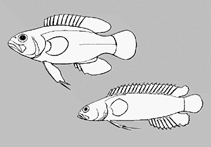Upload your photos and videos
Google imageNo image available for this species;
drawing shows typical species in Plesiopidae.
Google imageNo image available for this species;
drawing shows typical species in Plesiopidae.
Classification / Names आम नाम | उपशब्द | Catalog of Fishes(वर्ग, प्रजाति) | ITIS | CoL | WoRMS | Cloffa
> Ovalentaria/misc (Various families in series Ovalentaria) > Plesiopidae (Roundheads) > Acanthoclininae
Etymology: Acanthoclinus: Greek, akantha = thorn + Greek, klinein, kline = sloping and bed, due to the four apophyses of sphenoid bone (Ref. 45335).
More on author: Forster.
Etymology: Acanthoclinus: Greek, akantha = thorn + Greek, klinein, kline = sloping and bed, due to the four apophyses of sphenoid bone (Ref. 45335).
More on author: Forster.
Environment: milieu / climate zone / depth range / distribution range पारिस्थितिकी
समुद्री ड़िमरसल. Subtropical; 23°S - 43°S, 150°E - 176°E (Ref. 56303)
वितरण देश | ऐफ ऐ ओ क्षेत्र | Ecosystems | संयोग | Point map | भूमिका | Faunafri
Southwest Pacific: New Zealand.
आकार / वज़न / Age
Maturity: Lm ? range ? - ? cm
Max length : 20.0 cm TL पुल्लिंग / अलिंग; (Ref. 51568); अधिकतम सूचित उम्र: 9 वर्षो (Ref. 51568)
Max length : 20.0 cm TL पुल्लिंग / अलिंग; (Ref. 51568); अधिकतम सूचित उम्र: 9 वर्षो (Ref. 51568)
Eggs are guarded by the male parent (Ref. 205).
Life cycle and mating behavior परिपक्व अवधि | पुनरुत्पत्ति | मछलीऔ का अंडे देना | अंडे | Fecundity | लार्वा
Eggs are guarded by the male parent (Ref. 205).
Main reference
Upload your references | संदर्भ | संयोजक | सहयोगीयो
Francis, M.P., 1996. Geographic distribution of marine reef fishes in the New Zealand region. N.Z. J. Mar. Freshwat. Res. 30:35-55. (Ref. 45524)
CITES
Not Evaluated
Threat to humans
Harmless
Human uses
FAO - Publication: search | FishSource |
अधिक जानकारी
Population dynamics
Growth parameters
Max. ages / sizes
Length-weight rel.
Length-length rel.
Length-frequencies
Mass conversion
भर्ती
बहुतायत
Growth parameters
Max. ages / sizes
Length-weight rel.
Length-length rel.
Length-frequencies
Mass conversion
भर्ती
बहुतायत
Life cycle
पुनरुत्पत्ति
परिपक्व अवधि
Maturity/Gills rel.
Fecundity
मछलीऔ का अंडे देना
Spawning aggregations
अंडे
Egg development
लार्वा
लारवल गतिकी
पुनरुत्पत्ति
परिपक्व अवधि
Maturity/Gills rel.
Fecundity
मछलीऔ का अंडे देना
Spawning aggregations
अंडे
Egg development
लार्वा
लारवल गतिकी
Anatomy
गिल क्षेत्र
Brain
Otolith
गिल क्षेत्र
Brain
Otolith
Physiology
Body composition
Nutrients
Oxygen consumption
Swimming type
Swimming speed
Visual pigments
Fish sound
Diseases & Parasites
Toxicity (LC50s)
Body composition
Nutrients
Oxygen consumption
Swimming type
Swimming speed
Visual pigments
Fish sound
Diseases & Parasites
Toxicity (LC50s)
Genetics
आनुवंशिकी
Heterozygosity
हैरेटिबिलटी
आनुवंशिकी
Heterozygosity
हैरेटिबिलटी
साधन
E-book | कार्यक्षेत्र पथप्रदर्शक | लंबाई आवृति इंद्रजालिक | जीवन-इतिहास उपकरण | बिन्दु नक्शा | Classification Tree
| Catch-MSY |
Special reports
Download XML
Summary page | Point data | आम नाम | Photos
इंटरनेट स्रोत
AFORO (otoliths) | Aquatic Commons | BHL | Cloffa | BOLDSystems | Websites from users | Check FishWatcher | CISTI | Catalog of Fishes: वर्ग, प्रजाति | DiscoverLife | ECOTOX | FAO - Publication: search | Faunafri | Fishipedia | Fishtrace | GenBank: genome, nucleotide | GloBI | Google Books | Google Scholar | Google | IGFA World Record | MitoFish | Otolith Atlas of Taiwan Fishes | PubMed | Reef Life Survey | Socotra Atlas | Tree of Life | Wikipedia: Go, खोज | World Records Freshwater Fishing | Zoological Record
Estimates based on models
Phylogenetic diversity index (Ref. 82804): PD50 = 0.5312 [Uniqueness, from 0.5 = low to 2.0 = high].
Bayesian length-weight: a=0.00457 (0.00175 - 0.01195), b=3.11 (2.88 - 3.34), in cm total length, based on LWR estimates for this (Sub)family-body shape (Ref. 93245).
Trophic level (Ref. 69278): 3.4 ±0.52 se; based on food items.
Generation time: 3.3 ( na - na) years. Estimated as median ln(3)/K based on 2 growth studies.
लौटाव (Ref. 120179): माध्यम, न्यूनतम जनसंख्या दुगनी होने का समय 1.4 - 4.4 वर्ष। (tmax=9; K=0.4).
Fishing Vulnerability (Ref. 59153): Low vulnerability (10 of 100).




